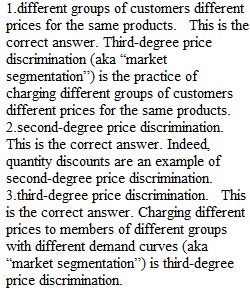


Q Question 1 1 / 1 pts Third-degree price discrimination is the practice of charging Question 2 1 / 1 pts A firm produces a good with constant marginal cost. The firm charges $10 per unit for the first 100 units, and $5 per unit for any additional units purchased by a consumer. This is known as Question 3 1 / 1 pts A tennis pro charges $15 per hour for tennis lessons for children and $30 per hour for tennis lessons for adults. The tennis pro is practicing Question 4 1 / 1 pts When a monopolist engages in perfect price discrimination:
View Related Questions